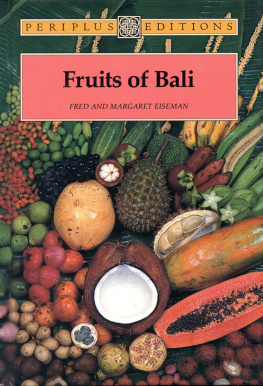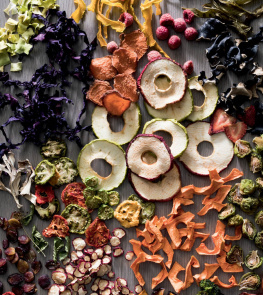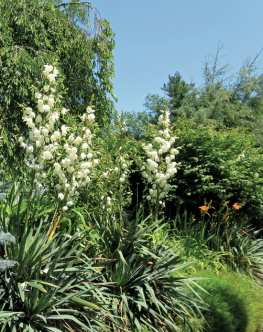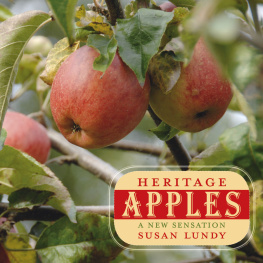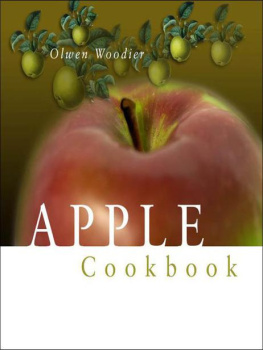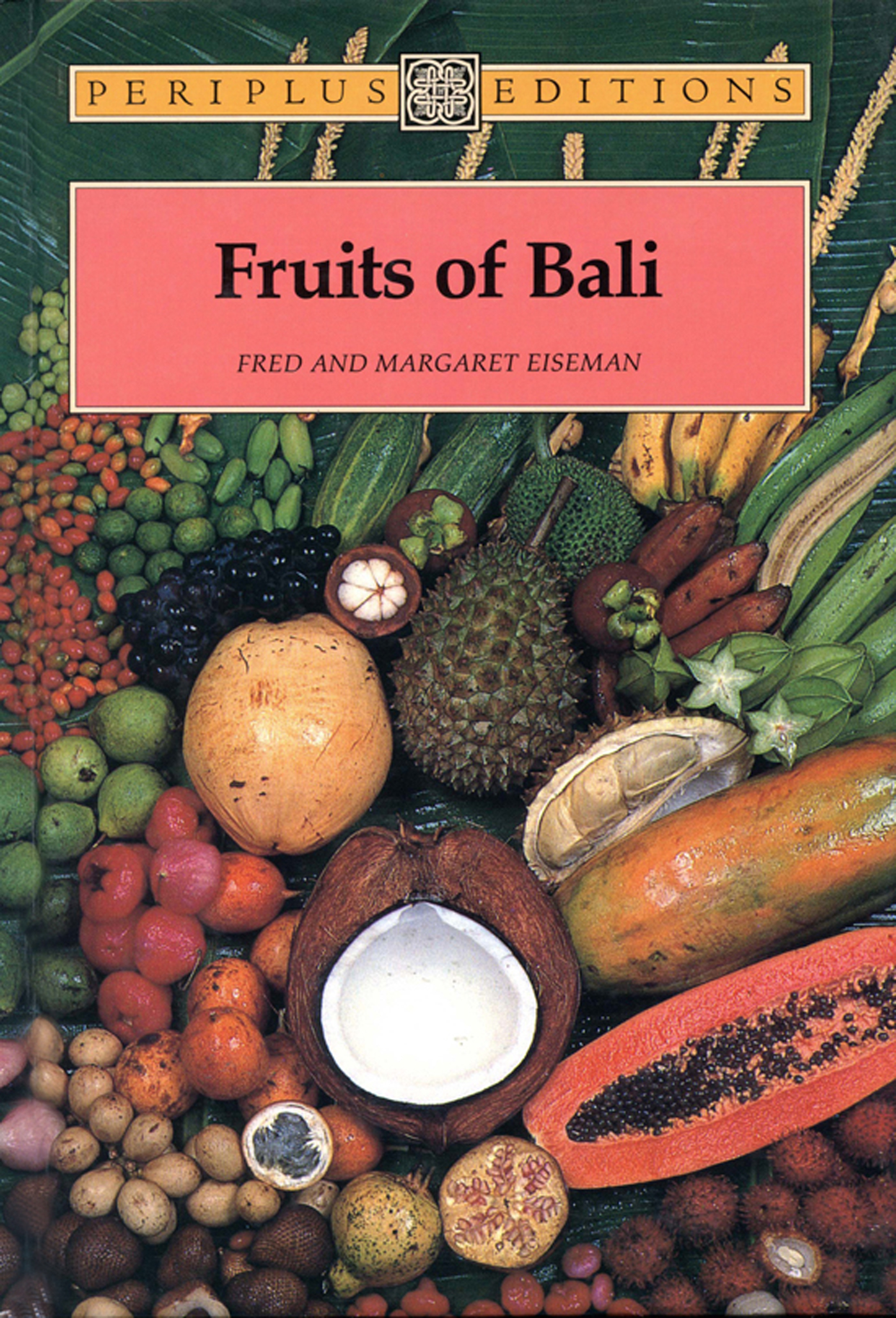Cover Page
Title
Fruits of Bali
Fruits of Bali
FRED AND MARGARET EISEMAN
PERIPLUS EDITIONS BERKELEY-SINGAPORE
Copyright 1988 Fred and Margaret Eiseman
ALL RIGHTS RESERVED
No portion of this book may be copied
or otherwise reproduced without
written approval from the publisher.
Published by PERIPLUS EDITIONS
1442A Walnut Street #206
Berkeley, California 94709
The United States of America
Distributed in Indonesia by
JAVA BOOK DISTRIBUTORS
PO Box 55 JKCP
Jakarta 10510
PUBLISHER: Eric M. Oey
EDITED BY: Anne Cherian
COVER: Pete Ivey
DESIGN: Pete Ivey and David Pickell
PRODUCTION: David Pickell
PHOTOGRAPHY: Fred and Margaret Eiseman
Library of Congress Catalog Card Number: 88-61078
ISBN: 978-1-4629-0879-0 (ebook)
Printed in Singapore
Frontispiece: Bali's most "typical" fruit, salak, in a 19th Century print
by G. Severegne after a drawing by Berthe Hoola van Nooten. Courtesy
of Antiques of the Orient, Singapore.
Dedication
We dedicate this book to Njoman Oka, our friend since 1961, with appreciation for all the things he has taught us.
The first Balinese we met and our first guide, Njoman even then had the reputation of being the premier guide in Bali, having helped anthropologists whose names are now legendary. In those days guiding was more arduous than simply taking a bus load of tourists to the barong show at Batubulan and then to lunch at a restaurant in Kintamani. Guiding meant exploration via byroads not well-worn by tour groups; it meant getting up at midnight to attend an unusual ceremonyessentially, it meant a hands-on introduction to a culture we never dreamed existed.
Njoman had a wealth of experience upon which to draw. He had been, among other things, a resistance fighter against the Dutch, Bupati of Tabanan, head of a school and director of a successful travel agency.
Njoman's reputation has been enhanced in the 27 years since our first encounter. He has been our friend at countless events and an advisor on every imaginable subject. It is no exaggeration to say that our interest in Bali was originally sparked by that first meeting. And this spark kindled a flame that has burned bright in our minds ever since.
Njoman has taught German at his beloved Saraswati school and remains active to this day guiding selected clients. Many members of his large family are reputable guides. He goes several times a week to Tabanan where he actively sponsors a Pasantian, a group of villagers who meet regularly to perfect their knowledge of, and ability to read and chant the sacred Hindu stories and scriptures. He writes frequent letters to the editor of the Bali Post, taking well-aimed jabs at developments he feels are detrimental to Bali's long term cultural preservation. He, of all the Balinese we know, has most successfully straddled two cultures, taking the best from East and West.
To Njoman Oka, we say:
Thank you for introducing Bali to us, and for your continued help and valued counsel. Had it not been for you, we probably would never have had the experiences that have occupied our minds and our pens for so many years.
Fruit stalls at the market in Sukawati.
Introduction
Shopping for some of Bali's interesting native fruits is just as necessary to complete your experience here as seeing the Batubulan Barong Show or visiting Kintamani, the Monkey Forest and Tanah Lot. And what's more, it takes less time, and is a lot cheaper. If you haven't yet tested the defenses of a Durian or tried to figure out how to peel a mango, you haven't yet had the full "Bali experience."
The fruits of Bali are not unique to the island. You will find the same varieties throughout much of tropical and sub-tropical Asia. But because Bali is so small, during the course of a year you can find practically all of them, freshly picked, waiting for your inspection or purchase at a local village fruit market within a few hundred meters' walk or a few hundred rupiahs' bemo ride from wherever you are staying. And what you will be eating is not imported; almost all of the fruit sold in Bali is homegrown.
Inspecting Balinese fruits does not consist of ordering them already peeled and cut up and nestled in a bed of shaved ice on the best crystal at a fancy hotel. Inspection means a one-on-one, eyeball-to-eyeball, closeup encounter with fruits piled on the counter of a stall in the market or spread out on a mat on the edge of a street on market day. This is the way the Balinese buy them.
Buying fruits is much cheaper than buying paintings or woodcarvings, and you will have just as much fun bargaining with the sellersprobably the only Balinese with whom you will interact who have not been trained to cater to the peculiarities of foreigners. Body language is quite sufficient. And you are not obligated to buy anything, although you are missing something if you don't.
We have included in this book all of the fruits that a visitor is likely to encounter in Baliunless he makes a deliberate effort to search for the most unusual ones. We have omitted some fruits commonly found in the West, such as grapes and strawberries. These are grown in Bali, but chances are that they are available at home and that you are already familiar with them. We have also omitted dozens of scattered local fruit varieties because these almost never find their way to market. As soon as they are ripe little boys knock them off the trees with stones and eat them on the spot. These little boys are true fruit lovers.
In Bali, in almost all cases, fruits are grown by small landholders as a source of income incidental to some other principal occupation. It costs nothing to plant a few fruit trees in the houseyard. The plants have not been specially bred. They have not been selected on the basis of how well the fruits that they yield will withstand shipping or how pretty they are, as is the case in many Western markets. They are not sprayed, fertilized, cultivated, and nursed along until the fruits are just underripe and of perfect shape, so that they will reach the market at the peak of quality. And so you will see that Balinese fruits will often not have the unblemished exteriors that seem to be necessary to attract Western buyers. The lack of careful genetic selection also results in considerable variability in taste and quality.
Most fruits are raised on scattered small holdings, often quite far from the main roads. With one or two exceptions there are no large fruit farms or orchards such as one finds in the West. Fruits are brought to market from the farms by professional collectors who have regular territories and customers. So, even if one were able to find an area where a particular fruit is grown in abundance, and even if he arrived at the peak of the season, he would likely find no fruits on the plants because of their recent harvest by the collectors.

